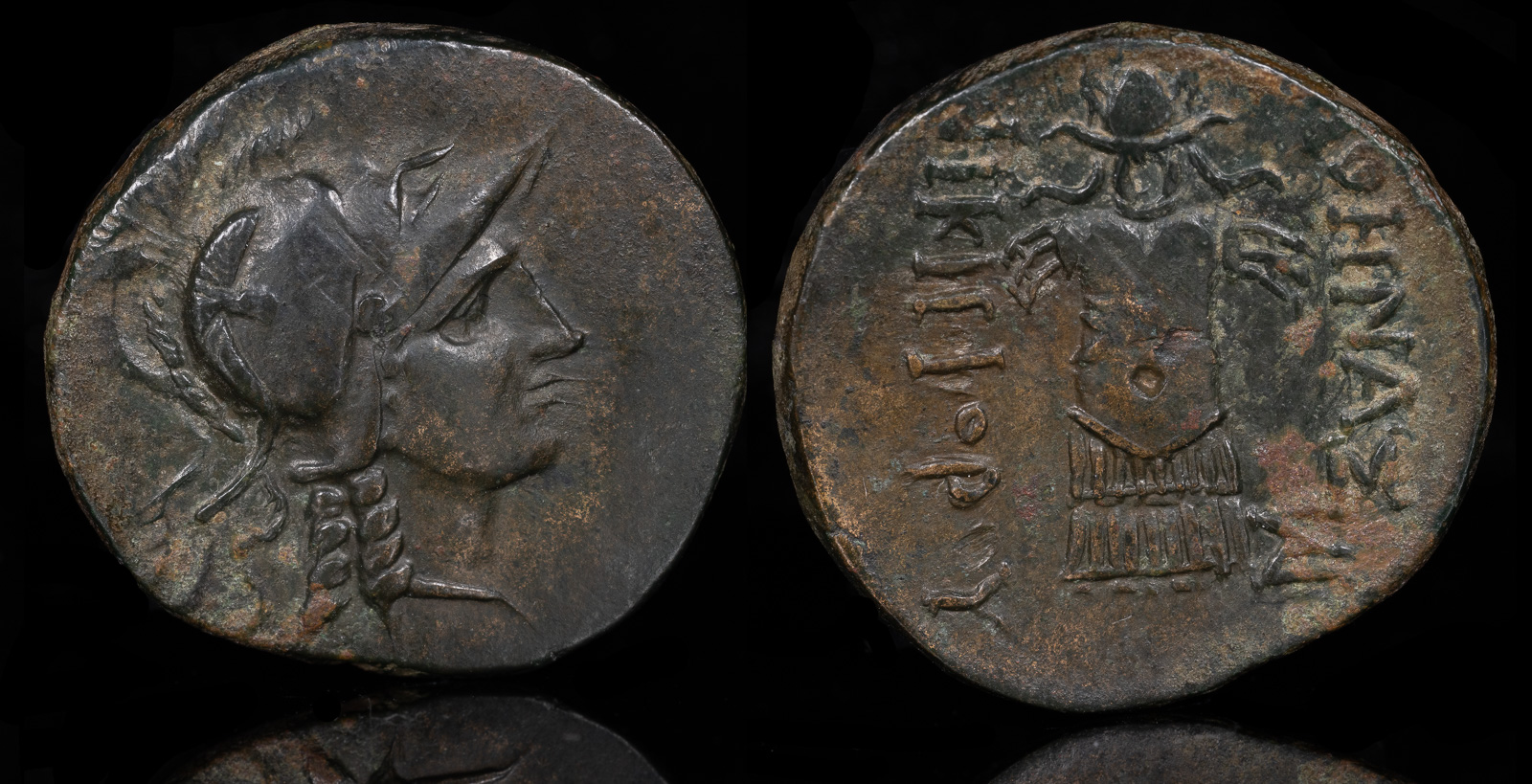
Mysia, Pergamon
Circa 310-282 BCE
AE 18 mm, 3.82 g, 2 h
Helmeted and laureate head of Athena to left.
Rev. ΠΕΡΓA Confronted bull’s heads; below, thunderbolt.
SNG Copenhagen 326 var. (thunderbolt above). SNG Paris 1577-9
ex BCD collection
Pergamon was the preeminent city in Mysia and one of the most influential within the Greek world. Its altar is a cornerstone of the Pergamon Museum in Berlin and its library was second only to the one in Alexandria in size and fame.
The coin above was minted around the time of Lysimachos, when he had control over the city, although by that time it was already ancient and renowned.

Mysia. Pergamon. Civic Issue Æ11 / Stars
310-282 BCE 9.94mm 1.07g
Obverse: Helmeted head of Athena right
Reverse: Two six-pointed stars side-by-side; Θ above, ΠEPΓ below
SNG France 1587; SNG Copenhagen 325
Ex Gorny & Mosch Auction 170 (13 October 2008), lot 3214 (part)
Ex Marc Breitsprecher
This coin was also minted roughly during that period, and contains two stars that I find interesting. Most likely they symbolize the Dioscuri, but I’m curious. This is an early time for the Dioscuri to be symbolized, but it’s also possible that the coin comes from later.

Pergamene Kingdom
Pergamon (Bergama, Turkey) mint
282 – 133 BCE
AE 3.675g, 15.7mm
obverse helmeted head of Athena right, crested helmet ornamented with a griffin;
reverse coiled snake with head right, M upper left, ΦIΛETAIPOY (Philetairos) downward on right
cf. SNG BnF 1660; SNG Cop 347; BMC Mysia p. 122, 78
Ex Errett Bishop Collection;
In 281 BCE Philetairos took the reigns and started the Attalid dynasty that would rule until Roman times. During this period the city only gained in power and prestige.

Mysia. Pergamon / Trophy
Circa 133-27 BCE 21.76mm 7.50g
Obverse: Helmeted head of Athena right
Reverse: ΑΘΗΝΑΣ – ΝΙΚΗΦΟΡΟΥ, trophy of armor
SNG France 1893
This coin was minted when Rome had become the preeminent power in the region and had occupied Pergamon. The trophy on the obverse struck me and I’m considering using it as the cover for an upcoming novel – tentatively called “Love, Macedonians, and Dinosaurs.”
March
Xenophon’s command of the 10,000 ends at Pergamon.
Orontas takes a leadership role in the Great Satraps Revolt. He then switches his allegiance to Artaxerxes II. He uses Pergamon as his base.
Orontas revolts again and takes Pergamon. He eventually reconciles with Artaxerxes III and ends the revolt.
Lysimachos appoints Philetairos commander of Pergamon, including its vast treasury.
Philetairos deserts Lysimachos and offers Pergamon to Seleukos I Nikator. This begins the Kingdom of Pergamon.
Eumenes I becomes ruler of the Kingdom of Pergamon after the death of Philetairos.
Antiochos I Soter is defeated while attempting to retake Pergamon by the Attalid Eumenes I in a battle near Sardis.
Construction of the Library of Pergamon begins.
197 BCE
Death of Attalos I of Pergamon. Eumenes II becomes king.
New city walls are constructed in Pergamon.
Priansos and other cities in Crete sign an alliance with Eumenes II of Pergamon.
The Pergamon Altar is constructed.
Attalos II ascends the throne of Pergamon.
The Library at Pergamon reaches its peak form.
Death of Attalos II of Pergamon. Attalos III ascends the throne.
Adramytteion, Ephesos, Pergamon, Magnesia, Tralles, Apamea, Samos, Kolophon, Smyrna, and Sardis occupied by Mithridates VI as part of the Mithridatic Wars against Rome.
Mithridates VI makes Pergamon his headquarters of his war against Rome.
Sulla defeats Mithridates VI and ends the Mithridatic Wars with the Treaty of Dardanos. Adramytteion, Ephesos, Pergamon, Smyrna, Sardis, Tralles, Kolophon, Apamea, and Magnesia return to Roman control.
Sulla uses Kypsela as a base while Mithridates uses Pergamon, and between these places they meet.
Marc Antony seizes 200,000 scrolls from the Library at Pergamon and gifts them to Kleopatra for the Library at Alexandria.